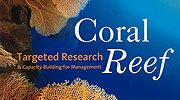|
Connectivity and large-scale ecological processes
 << Members >> << Members >>
Coral reefs are patchily distributed in an ocean that provides the possibility of transport among them.
Connectivity can be defined as the movement of items between locations. It exists for nutrients, sediments, and pollutants, but in the context of coral reef management, connectivity in the form of the effective transfer of individuals (usually waterbourne larvae) between local populations is the most important, and also the most difficult to measure.
While the transfers of non-living materials is likely to be determined primarily by local and regional hydrodynamics, we know that the transfer of organisms (demographic connectivity) is more complex since passive transport due to hydrodynamics is modified by the sensory and behavioral capabilities of marine larvae.
Effective transfer also involves successful establishment as a part of a breeding population, so connectivity among populations is not simply measured by focusing on dispersal patterns, but must include successful recruitment to the receiving population.
Presently, the design of Marine Protected Areas (MPA) containing coral reefs and their implementation uses educated guesses to decide appropriate size and Location. There is little information to determine whether these guesses are even approximately correct.
The use of MPAs assumes connectivity. Either MPAs are established at a size believed large enough to encompass all stages of the life cycle of species being sustained, or they are established at a size and locations that will improve establishment of species to surrounding sites due to dispersal beyond MPA boundaries.
At present we lack quantitative data on demographic connectivity, yet these data are essential if we are to improve our ability to design and implement networks of MPAs.
The Connectivity Working Group (CWG) is targeting these fundamental gaps in our knowledge. It is beginning its work in selected areas within the various regions of the program with the aim to develop specific tools and techniques necessary to address these critical questions.
The Group’s initial focus involves the following research:
 Larval biology and behavior. Larval biology and behavior.
The CWG will provide critical knowledge of the potential of connectivity in furthering management and conservation by studying several organisms simultaneously–ranging from spiny lobster with very lengthy larval phases, to corals with much shorter larval durations, to fishes with active larval swimming behavior.
Hydrodynamic and biophysical models to predict dispersal.
The spatial and temporal patterns in abundance of new recruits must be driven initially by patterns of dispersal from source locations in a region. Using biophysical models to track dispersal through larval life from selected source locations, it should be possible to generate maps of “settlement intensity” to compare with observed recruitment patterns. Congruence will suggest that models are sufficiently precise to describe patterns of connectivity among locations. Deviations will drive further work to improve hydrodynamic models, and to explore capabilities for active movement. The nature of the deviations will provide cues to factors that may be important in determining connectivity patterns for various species.
Genetics.
Movement experiments on corals and fish will use genetic data to reliably identify progeny from particular mass spawnings and dispersals. Coral studies will also use genetic patterns expressed in cohorts of differing age to determine if there have been measurable changes in patterns of connectivity in recent decades (during a time when Caribbean coral populations have suffered serious declines)
|

